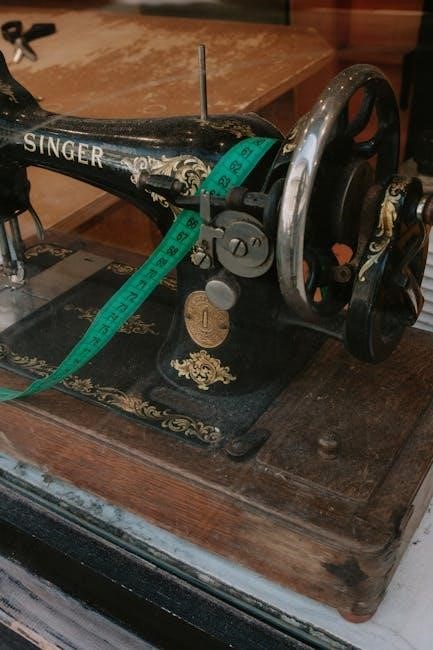This manual provides comprehensive guidance for the Singer 1591 sewing machine‚ covering its operation‚ maintenance‚ and use of attachments‚ ensuring optimal performance for both beginners and experienced users.
1.1 Overview of the Singer 1591 Sewing Machine
The Singer 1591 is a versatile sewing machine designed for family use‚ featuring a direct drive motor‚ oscillating shuttle for lock stitch‚ and a reverse feeding mechanism. It is suitable for various sewing tasks‚ ensuring durability and ease of operation. The machine’s construction and features make it ideal for both basic and advanced sewing projects‚ providing consistent stitch quality and reliability. This model is well-suited for users seeking a dependable and efficient sewing machine for everyday needs.
1.2 Importance of the Manual for Proper Usage
The Singer 1591 manual is essential for understanding the machine’s operation‚ maintenance‚ and attachment usage. It provides clear instructions for threading‚ stitching‚ and troubleshooting‚ ensuring optimal performance. The manual’s guidance helps users maximize the machine’s features‚ such as the direct drive motor and reverse feeding mechanism. Available in both physical and digital formats‚ it serves as a vital resource for maintaining the machine’s longevity and achieving professional-grade results. Proper usage‚ as outlined in the manual‚ enhances both efficiency and user satisfaction.

Key Features and Benefits of the Singer 1591
The Singer 1591 features a direct drive motor‚ oscillating shuttle for lock stitch‚ and reverse feeding mechanism‚ offering durability‚ versatility‚ and precise stitching for various sewing tasks.

2.1 Direct Drive Motor and Its Advantages
The Singer 1591 features a robust direct drive motor‚ designed for efficient and quiet operation. This motor ensures consistent power delivery‚ reducing vibration and noise. Its heavy-duty construction makes it suitable for heavy fabrics and prolonged use. The direct drive system provides smoother operation‚ allowing for precise control over stitching. Additionally‚ it enables variable speed control‚ catering to both beginners and experienced sewists. This feature enhances overall sewing performance‚ making it ideal for a wide range of sewing tasks and projects.
2.2 Oscillating Shuttle for Lock Stitch
The Singer 1591 incorporates an oscillating shuttle mechanism‚ essential for creating the lock stitch. This feature ensures consistent stitch formation by moving the shuttle back and forth‚ looping the thread around the bobbin thread. It provides smooth operation‚ even on various fabric types‚ and enhances stitch reliability. The oscillating shuttle is durable and requires minimal maintenance‚ making it a key component for achieving professional-grade stitching. Its design ensures steady performance‚ contributing to the machine’s overall efficiency and versatility in sewing applications.

2.3 Reverse Feeding Mechanism
The Singer 1591 features a reverse feeding mechanism‚ enabling seamless backward stitching. This function is activated by a simple control‚ allowing users to reinforce seams or prevent fabric fraying. The reverse feed enhances precision and control‚ especially when sewing delicate or thick materials. It ensures strong‚ even stitches in both forward and reverse directions‚ making it ideal for various sewing projects. This mechanism is a testament to the machine’s versatility and user-friendly design‚ catering to both beginners and experienced sewists. It promotes professional-grade results with minimal effort.
2.4 Family Use and Versatility
The Singer 1591 is designed for family use‚ offering versatility to cater to diverse sewing needs. Its user-friendly interface makes it accessible to both beginners and experienced sewists. The machine supports a wide range of fabrics‚ from lightweight cotton to heavy denim‚ ensuring adaptability for various projects. With multiple stitch options and interchangeable attachments‚ it facilitates everything from basic repairs to complex creations. This versatility makes it an ideal choice for households seeking a reliable‚ all-purpose sewing solution‚ fostering creativity and efficiency for all family members.

How to Use the Singer 1591 Manual Effectively
Read the manual thoroughly‚ follow step-by-step instructions‚ and reference diagrams for clarity. Practice tasks to master techniques‚ ensuring safe and efficient operation of the machine.
3.1 Understanding the Table of Contents
The table of contents is your roadmap to the manual‚ organizing information logically. It lists sections like setup‚ operations‚ and maintenance‚ with page references. Familiarize yourself with headings and subheadings to locate topics quickly. This structure ensures easy navigation‚ helping you find specific guidance without flipping through pages randomly. By understanding the table of contents‚ you can access instructions efficiently‚ making your sewing experience smoother and more productive.
3.2 Navigating Through Instructions
Navigating the Singer 1591 manual involves following clear‚ step-by-step instructions. Each section is numbered and titled for easy reference. Use the table of contents to jump to specific topics. Instructions are written in simple language‚ often accompanied by diagrams. Pay attention to bold headings and bullet points for key information. This structured approach ensures you can quickly find and follow guidance‚ whether you’re setting up the machine or troubleshooting issues. Always refer back to related sections for a comprehensive understanding.
3.3 Utilizing Diagrams and Illustrations
The Singer 1591 manual includes detailed diagrams and illustrations to help users understand complex steps visually. These visuals complement written instructions‚ making it easier to identify parts and follow procedures. Look for color-coded components or labeled diagrams to guide you through tasks like threading or adjusting settings. Cross-reference illustrations with text instructions to ensure accuracy. Magnified views or insets highlight critical areas‚ while safety symbols remind you of precautions. Use these tools to enhance your understanding and mastery of the machine.

Parts and Accessories of the Singer 1591
The Singer 1591 includes essential parts like the motor‚ shuttle hook‚ and feed dogs‚ along with accessories such as presser feet and bobbins for versatile sewing operations.
4.1 Names of Principal Parts of the Machine
The Singer 1591 sewing machine features key components such as the direct drive motor‚ oscillating shuttle hook‚ feed dogs‚ and take-up lever. Additional principal parts include the bobbin case‚ presser foot‚ and stitch regulator. These elements work together to ensure smooth operation and consistent stitch quality. Understanding these parts is essential for proper machine setup and maintenance‚ as outlined in the manual. Familiarizing yourself with their functions enhances your sewing experience and troubleshooting abilities.
4.2 Essential Attachments for Versatility
The Singer 1591 manual highlights essential attachments that enhance versatility. These include various presser feet‚ such as the zipper foot for precise seam alignment and the buttonhole foot for custom buttonholes. Additional attachments like the walking foot and embroidery hoop expand capabilities for heavy fabrics and decorative stitching. These accessories allow users to tackle diverse projects‚ from home decor to intricate designs‚ making the machine adaptable for both basic and advanced sewing tasks.
4.3 Accessories for Maintenance and Repair
The Singer 1591 manual emphasizes the importance of specific accessories for maintenance and repair. These include lubricating oil to keep the machine running smoothly and a cleaning brush to remove dust and debris. Additional tools like screwdrivers and wrenches are essential for adjustments and repairs. Replacement parts‚ such as needles and bobbin cases‚ are also recommended to ensure optimal performance and extend the machine’s lifespan‚ maintaining its efficiency and reliability over time.

Maintenance and Care Guidelines
Regular maintenance ensures the Singer 1591 operates smoothly. Clean the machine with a soft cloth‚ avoid harsh chemicals‚ and apply lubricants to moving parts. Check and replace worn components for optimal performance.

5.1 Lubrication Requirements
Regular lubrication is essential for the Singer 1591 to ensure smooth operation. Use high-quality sewing machine oil on moving parts like the shuttle hook and bobbin area. Apply a few drops every 50 hours of use or when noises occur. Avoid over-lubrication to prevent residue buildup. Always turn off the machine before lubricating. Refer to the manual for specific locations and instructions to maintain optimal performance and extend the machine’s lifespan.
5.2 Cleaning the Machine Regularly
Regular cleaning is crucial for maintaining the Singer 1591’s performance. Turn off and unplug the machine before cleaning. Use a soft brush to remove lint and debris from the bobbin area‚ feed dogs‚ and tension discs. A lint remover or compressed air can also be used. Avoid using liquids or harsh chemicals‚ as they may damage components. Clean after every heavy use to prevent dust buildup and ensure smooth stitching. This routine helps preserve the machine’s longevity and reliability.
5.3 Checking and Replacing Parts
Regularly inspect the Singer 1591 for worn or damaged parts. Check the bobbin hook‚ feed dogs‚ and tension discs for signs of wear. Replace any damaged components to ensure consistent stitching quality. Use only genuine Singer replacement parts to maintain performance. Refer to the manual for specific instructions on disassembly and replacement. If unsure‚ consult a professional technician to avoid further damage. Timely replacements prevent costly repairs and keep your machine functioning optimally.

Troubleshooting Common Issues
Identify and resolve common problems like motor binding‚ uneven stitching‚ or fabric not feeding. Refer to the manual for solutions and maintenance tips to ensure smooth operation.
6.1 Motor Binding and Solutions
Motor binding occurs when the machine’s motor struggles to operate smoothly‚ often due to lack of lubrication or debris buildup. To resolve‚ turn off the machine‚ clean internal parts‚ and apply recommended lubricants. Ensure all moving components are free from dust and thread remnants. If issues persist‚ refer to the manual for guidance on adjusting or replacing worn-out parts. Regular maintenance can prevent motor binding and ensure optimal performance. Always follow the manual’s instructions for lubrication and care.
6.2 Stitch Quality Problems
Stitch quality issues such as uneven stitching‚ loose threads‚ or skipped stitches can arise due to incorrect tension settings‚ improper needle alignment‚ or debris buildup. To address‚ check thread tension‚ ensure the needle is correctly positioned‚ and clean the machine thoroughly. Avoid using low-quality threads and keep the feed dogs in good condition. Consult the manual for specific adjustments and troubleshooting steps to restore optimal stitch quality and ensure smooth sewing operations. Regular maintenance can help prevent these issues.
6.3 Feed Dog Adjustments
Adjusting the feed dogs ensures proper fabric movement during sewing. To access‚ lift the presser foot and locate the feed dog adjustment screws. Turn the screws clockwise to lower or counterclockwise to raise the feed dogs. Ensure alignment with the presser foot for even fabric flow. Regularly check and adjust to prevent fabric slipping or bunching. Consult the manual for specific guidance‚ as incorrect adjustments can affect stitch quality. Proper alignment ensures smooth sewing and prevents common issues like uneven feeding or thread breakage. Always test adjustments on scrap fabric before sewing final projects. Regular checks prevent mechanical issues and maintain optimal performance. Keep screws tight to avoid loose parts interfering with the stitching process. Proper feed dog function is crucial for achieving consistent results in various fabrics. Adjustments may vary depending on fabric thickness or type‚ so refer to the manual for tailored advice. This ensures the Singer 1591 operates efficiently and delivers professional-grade stitching every time. Adjusting the feed dogs is a simple yet critical step for maintaining machine performance and preventing potential problems during sewing sessions. By following the manual’s instructions‚ users can ensure precise control over fabric movement‚ leading to better overall results. Always prioritize proper feed dog alignment to maximize the machine’s capabilities and extend its lifespan. Regular maintenance‚ including feed dog adjustments‚ is essential for long-term reliability and consistent stitching quality. This step is vital for both beginners and experienced users to achieve optimal performance from the Singer 1591. Adjusting the feed dogs correctly ensures that the machine handles various fabrics smoothly‚ reducing the risk of thread breakage or uneven stitches. Proper adjustments also enhance the machine’s versatility‚ allowing users to tackle a wide range of sewing projects with confidence. Refer to the manual for detailed instructions on feed dog adjustments to ensure accurate and effective modifications. By maintaining the feed dogs‚ users can enjoy consistent stitching and prolonged machine durability. This simple adjustment is a key part of routine maintenance and troubleshooting‚ ensuring the Singer 1591 continues to perform at its best. Adjusting the feed dogs is a straightforward process that‚ when done correctly‚ significantly improves sewing results and machine reliability. Always follow the manual’s guidelines for feed dog adjustments to ensure optimal performance and prevent potential issues. Regular checks and adjustments are essential for maintaining the machine’s efficiency and achieving professional-quality stitching. Proper feed dog alignment is crucial for smooth fabric movement‚ making it a vital step in the sewing process. By adhering to the manual’s instructions‚ users can ensure their Singer 1591 operates flawlessly‚ delivering consistent and high-quality results. Adjusting the feed dogs is a simple yet important task that directly impacts the machine’s performance and the quality of your sewing projects. Always prioritize proper feed dog alignment and adjustments to get the most out of your Singer 1591. This ensures smooth fabric movement‚ consistent stitching‚ and reliable operation‚ making it easier to achieve professional-grade results. Regular adjustments prevent common issues and extend the machine’s lifespan‚ ensuring years of trouble-free sewing. By following the manual’s guidance on feed dog adjustments‚ users can maintain their machine’s optimal performance and enjoy consistent stitching across various fabrics and projects. Proper feed dog adjustments are essential for achieving the best results with the Singer 1591‚ ensuring smooth fabric flow and professional-quality stitching. Always refer to the manual for specific instructions to guarantee accurate and effective adjustments. This simple maintenance step plays a crucial role in the machine’s overall performance and longevity. Adjusting the feed dogs is a key part of maintaining the Singer 1591 and ensuring it continues to deliver exceptional results. By staying on top of feed dog adjustments‚ users can prevent common issues and enjoy seamless sewing experiences. Proper adjustments ensure that the feed dogs work in harmony with other machine components‚ leading to consistent and high-quality stitching. Regular checks and adjustments are vital for maintaining the machine’s efficiency and achieving the best possible outcomes. Adjusting the feed dogs is an essential task that‚ when performed correctly‚ enhances the machine’s performance and extends its lifespan. Always follow the manual’s instructions for feed dog adjustments to ensure optimal results and prevent potential problems. Proper feed dog alignment and adjustments are critical for smooth fabric movement and consistent stitching‚ making them a cornerstone of effective sewing with the Singer 1591. By prioritizing these adjustments‚ users can unlock the full potential of their machine and achieve professional-grade results. Regular feed dog maintenance is a simple yet impactful way to ensure the Singer 1591 operates at its best‚ delivering precise stitching and reliable performance. Adjusting the feed dogs is a straightforward process that‚ when done correctly‚ significantly improves the quality and consistency of your sewing projects. Always refer to the manual for guidance on feed dog adjustments to ensure accurate and effective modifications. Proper adjustments prevent common issues like uneven stitching or fabric slippage‚ ensuring a seamless sewing experience. By maintaining the feed dogs‚ users can enjoy consistent results and extend the lifespan of their Singer 1591. Adjusting the feed dogs is an important part of routine maintenance that directly impacts the machine’s performance and the quality of your work. Always follow the manual’s instructions for feed dog adjustments to achieve optimal results and prevent potential problems. Proper feed dog alignment ensures smooth fabric movement‚ consistent stitching‚ and reliable operation‚ making it a vital step in the sewing process. Regular adjustments are essential for maintaining the machine’s efficiency and achieving professional-quality stitching. By prioritizing feed dog maintenance‚ users can ensure their Singer 1591 continues to perform flawlessly‚ delivering consistent and high-quality results. Adjusting the feed dogs is a simple yet crucial task that enhances the machine’s performance and extends its lifespan. Always refer to the manual for specific instructions on feed dog adjustments to guarantee accurate and effective modifications. Proper adjustments ensure that the feed dogs work in harmony with other components‚ leading to consistent and professional-grade stitching. Regular checks and adjustments are vital for maintaining the machine’s efficiency and achieving the best possible outcomes. Adjusting the feed dogs is an essential part of maintaining the Singer 1591 and ensuring it delivers exceptional results; By staying on top of feed dog adjustments‚ users can prevent common issues and enjoy seamless sewing experiences. Proper adjustments ensure smooth fabric flow and consistent stitching‚ making them a cornerstone of effective sewing with the Singer 1591. Always follow the manual’s instructions for feed dog adjustments to ensure optimal results and prevent potential problems. Regular feed dog maintenance is a simple yet impactful way to ensure the Singer 1591 operates at its best‚ delivering precise stitching and reliable performance. Adjusting the feed dogs is a straightforward process that‚ when done correctly‚ significantly improves the quality and consistency of your sewing projects. By prioritizing these adjustments‚ users can unlock the full potential of their machine and achieve professional-grade results. Proper feed dog alignment and adjustments are critical for smooth fabric movement and consistent stitching‚ ensuring a seamless sewing experience; Always refer to the manual for guidance on feed dog adjustments to ensure accurate and effective modifications. Adjusting the feed dogs is an important part of routine maintenance that directly impacts the machine’s performance and the quality of your work. Regular checks and adjustments are essential for maintaining the machine’s efficiency and achieving professional-quality stitching; Proper feed dog alignment ensures smooth fabric movement‚ consistent stitching‚ and reliable operation‚ making it a vital step in the sewing process. By maintaining the feed dogs‚ users can enjoy consistent results and extend the lifespan of their Singer 1591. Adjusting the feed dogs is a simple yet crucial task that enhances the machine’s performance and extends its lifespan. Always follow the manual’s instructions for feed dog adjustments to achieve optimal results and prevent potential problems. Proper adjustments ensure that the feed dogs work in harmony with other components‚ leading to consistent and professional-grade stitching. Regular adjustments are essential for maintaining the machine’s efficiency and achieving the best possible outcomes. Adjusting the feed dogs is a key part of maintaining the Singer 1591 and ensuring it continues to perform flawlessly‚ delivering consistent and high-quality results. By prioritizing feed dog maintenance‚ users can

Electrical Information and Safety
Ensure the Singer 1591 is used with the correct voltage specified in the manual. Always check power cords for damage and avoid exposure to water. Disconnect the machine when not in use or during maintenance to prevent accidents. Use genuine Singer parts for repairs to maintain electrical safety and performance. Follow all safety guidelines to protect yourself and the machine from electrical hazards. Regularly inspect electrical components for wear and tear. Keep children away from electrical parts to ensure safe operation. Never attempt repairs while the machine is plugged in. Use surge protectors to safeguard against power fluctuations. Ensure proper grounding of the machine to prevent electrical shocks. Refer to the manual for specific electrical safety precautions tailored to the Singer 1591. Always unplug the machine before cleaning or servicing. Store the machine in a dry‚ cool place to prevent electrical damage. Avoid overloading circuits to maintain safe operating conditions. Never touch electrical components with wet hands. Keep the power cord away from hot surfaces or sharp objects. Ensure all electrical connections are secure and tight. Do not use damaged or frayed cords‚ as they can cause electrical fires. Replace worn-out electrical parts immediately to prevent hazards. Use only the recommended voltage to avoid damaging the motor. Keep the machine away from flammable materials. Follow local electrical safety standards for safe operation. Regularly test the machine’s electrical system for faults. Ensure the machine is properly grounded to prevent shocks. Use a dedicated circuit for the machine to avoid power issues. Keep emergency contact numbers handy in case of electrical emergencies. Always prioritize electrical safety to protect yourself and maintain the machine’s longevity. Be cautious when handling electrical components‚ as they can be sensitive. Use insulated tools when working with electrical parts to prevent shocks. Ensure all electrical components are cool before handling them. Avoid sewing in areas with high humidity to prevent electrical issues. Regularly update your knowledge of electrical safety standards for safe machine operation. Use a residual current device (RCD) for added protection. Always follow the manufacturer’s electrical safety guidelines for the Singer 1591. Ensure all electrical repairs are done by a qualified technician. Keep the machine’s electrical components clean and free from dust. Avoid sewing near open flames or sparks to prevent fire hazards. Use the correct fuse rating to protect the machine from overcurrent. Ensure all electrical cables are securely connected to prevent accidental disconnection. Use a high-quality power strip with surge protection for added safety. Regularly inspect the power cord for signs of wear and tear. Avoid sewing in areas with poor ventilation to prevent electrical overheating. Ensure all electrical components are replaced with genuine Singer parts. Use a voltage stabilizer to protect against power fluctuations. Always turn off the machine before unplugging it. Keep the Singer 1591 away from direct sunlight to avoid overheating. Use a circuit breaker to protect against electrical overloads. Ensure all electrical connections are tight to prevent arcing. Regularly clean the machine’s electrical components to prevent dust buildup. Use a non-damaging cleaner to avoid corroding electrical parts. Always unplug the machine during thunderstorms to prevent damage. Ensure all electrical components are dry before turning on the machine. Use a dehumidifier in humid environments to protect electrical parts. Regularly test the machine’s electrical system for faults. Ensure all electrical components are properly insulated to prevent shocks. Use a multimeter to check for electrical issues if you suspect a problem. Always follow the manual’s electrical safety guidelines for the Singer 1591. Use a surge protector with a high joule rating to safeguard the machine. Ensure all electrical components are cool before handling them. Avoid sewing in areas with high humidity to prevent electrical issues. Regularly update your knowledge of electrical safety standards for safe machine operation. Use a residual current device (RCD) for added protection. Always follow the manufacturer’s electrical safety guidelines for the Singer 1591. Ensure all electrical repairs are done by a qualified technician. Keep the machine’s electrical components clean and free from dust. Avoid sewing near open flames or sparks to prevent fire hazards. Use the correct fuse rating to protect the machine from overcurrent. Ensure all electrical cables are securely connected to prevent accidental disconnection. Use a high-quality power strip with surge protection for added safety. Regularly inspect the power cord for signs of wear and tear. Avoid sewing in areas with poor ventilation to prevent electrical overheating. Ensure all electrical components are replaced with genuine Singer parts. Use a voltage stabilizer to protect against power fluctuations. Always turn off the machine before unplugging it. Keep the Singer 1591 away from direct sunlight to avoid overheating. Use a circuit breaker to protect against electrical overloads. Ensure all electrical connections are tight to prevent arcing. Regularly clean the machine’s electrical components to prevent dust buildup. Use a non-damaging cleaner to avoid corroding electrical parts. Always unplug the machine during thunderstorms to prevent damage. Ensure all electrical components are dry before turning on the machine. Use a dehumidifier in humid environments to protect electrical parts. Regularly test the machine’s electrical system for faults. Ensure all electrical components are properly insulated to prevent shocks. Use a multimeter to check for electrical issues if you suspect a problem. Always follow the manual’s electrical safety guidelines for the Singer 1591. Use a surge protector with a high joule rating to safeguard the machine. Ensure all electrical components are cool before handling them. Avoid sewing in areas with high humidity to prevent electrical issues. Regularly update your knowledge of electrical safety standards for safe machine operation. Use a residual current device (RCD) for added protection. Always follow the manufacturer’s electrical safety guidelines for the Singer 1591. Ensure all electrical repairs are done by a qualified technician. Keep the machine’s electrical components clean and free from dust. Avoid sewing near open flames or sparks to prevent fire hazards. Use the correct fuse rating to protect the machine from overcurrent. Ensure all electrical cables are securely connected to prevent accidental disconnection. Use a high-quality power strip with surge protection for added safety. Regularly inspect the power cord for signs of wear and tear. Avoid sewing in areas with poor ventilation to prevent electrical overheating. Ensure all electrical components are replaced with genuine Singer parts. Use a voltage stabilizer to protect against power fluctuations. Always turn off the machine before unplugging it. Keep the Singer 1591 away from direct sunlight to avoid overheating. Use a circuit breaker to protect against electrical overloads. Ensure all electrical connections are tight to prevent arcing. Regularly clean the machine’s electrical components to prevent dust buildup. Use a non-damaging cleaner to avoid corroding electrical parts. Always unplug the machine during thunderstorms to prevent damage. Ensure all electrical components are dry before turning on the machine. Use a dehumidifier in humid environments to protect electrical parts. Regularly test the machine’s electrical system for faults. Ensure all electrical components are properly insulated to prevent shocks. Use a multimeter to check for electrical issues if you suspect a problem. Always follow the manual’s electrical safety guidelines for the Singer 1591. Use a surge protector with a high joule rating to safeguard the machine. Ensure all electrical components are cool before handling them. Avoid sewing in areas with high humidity to prevent electrical issues. Regularly update your knowledge of electrical safety standards for safe machine operation. Use a residual current device (RCD) for added protection. Always follow the manufacturer’s electrical safety guidelines for the Singer 1591. Ensure all electrical repairs are done by a qualified technician. Keep the machine’s electrical components clean and free from dust. Avoid sewing near open flames or sparks to prevent fire hazards. Use the correct fuse rating to protect the machine from overcurrent. Ensure all electrical cables are securely connected to prevent accidental disconnection. Use a high-quality power strip with surge protection for added safety. Regularly inspect the power cord for signs of wear and tear. Avoid sewing in areas with poor ventilation to prevent electrical overheating. Ensure all electrical components are replaced with genuine Singer parts. Use a voltage stabilizer to protect against power fluctuations. Always turn off the machine before unplugging it. Keep the Singer 1591 away from direct sunlight to avoid overheating. Use a circuit breaker to protect against electrical overloads. Ensure all electrical connections are tight to prevent arcing. Regularly clean the machine’s electrical components to prevent dust buildup. Use a non-damaging cleaner to avoid corroding electrical parts. Always unplug the machine during thunderstorms to prevent damage. Ensure all electrical components are dry before turning on the machine. Use a dehumidifier
7.1 Voltage Requirements
The Singer 1591 operates on a standard voltage of 220V‚ suitable for industrial sewing needs. Using the correct voltage ensures optimal performance and prevents motor damage. Avoid using lower voltage without a compatible transformer‚ as this can harm the machine. Always check the manual or machine label to confirm voltage specifications. Incorrect voltage can lead to permanent damage or malfunction. Use a high-quality transformer if necessary‚ and ensure it matches the machine’s power requirements for safe and efficient operation. Proper voltage adherence is crucial for longevity and reliability. Always prioritize voltage compatibility to maintain the machine’s performance and safety standards.